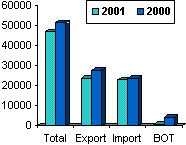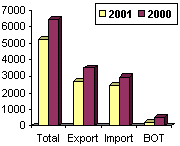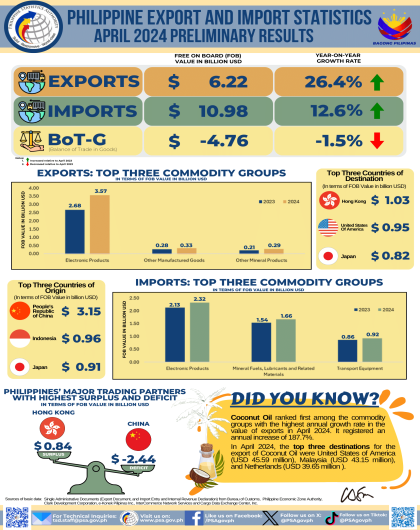Highlights of the Philippine Export and Import Statistics April 2024 (Preliminary)
JANUARY TO SEPTEMBER TOTAL TRADE STANDS AT $46.933 BILLION
Total external trade in goods for January to September 2001 amounted to $46.933 billion or 8.9 percent lower than $51.495 billion in 2000. Bill for foreign-made merchandise declined by 2.7 percent to $22.999 billion from $23.628 billion. On the other hand, exports posted a 14.1 percent year-on-year decrease reporting an aggregate dollar revenue of $23.934 billion down from $27.867 billion in 2000. Balance of trade surplus for the Philippines amounted to $936.0 million or 77.9 percent lower than last years $4.239 billion.
|
Fig. 1A. Philippine Trade |
Fig. 1B. Philippine Trade |
|
|
|
SEPTEMBER IMPORTS DECREASE BY 15.9 PERCENT
Total merchandise trade for September 2001, declined by 19.2 percent to $5.230 billion from $6.475 billion during the same period last year. Dollar-inflow generated by exports amounted to $2.731 billion, or a 22.0 percent decrease from last years $3.502 billion, while expenditures for imported goods declined by 15.9 percent to $2.499 billion from $2.973 billion. The BOT-G surplus stood at $232 million.
ELECTRONICS AND COMPONENTS ACCOUNT FOR 18.7 PERCENT OF IMPORT BILL
Accounting for 18.7 percent of the total aggregate import bill, payments for Electronics and Components amounted to $467.63 million or 30.4 percent lower than last year's $671.51 million. Compared to the previous month, dollar-outflow decreased by 9.4 percent from $516.21 million.
Purchases of Mineral Fuels, Lubricants and Related Materialsranked second with a 12.0 percent share. Payments made reached $299.92 million for a 21.4 percent decrease over last years $381.45 million.
Telecommunication Equipment and Electrical Machinery, the third top import reported purchases worth $249.89 million, or a 3.6 percent decrease from $259.15 million a year earlier.
Office and EDP Machines accounting for 8.2 percent of the total bill, ranked fourth as payments reached $205.58 million, higher by 33.0 percent from last year's $154.60 million.
Expenditures for Industrial Machinery and Equipment, combined for a 4.3 percent share of the aggregate bill, which declined by 38.2 percent to $107.22 million from $173.57 million.
Transport Equipment accounting for 4.3 percent of the total bill, was RPs sixth top import for the month with payments worth $106.60 million or 8.5 percent higher than last years $98.26 million.
Rounding up the list of the top imports for September 2001 were:Materials/Accessories Imported on Consignment Basis for the Manufacture of Other Electrical and Electronic Machinery and Equipment, $98.28 million; Textile Yarn, Fabrics, Made-up Articles and Related Products, $83.37 million; Iron and Steel, $74.70 million; Cereals and Cereal Preparation, $60.95 million.
Aggregate payment for the countrys top ten imports for September 2001 amounted to $1.754 billion or 70.2 percent of the total bill.
Fig. 2. Philippine Top Imports in September: 2000 & 2001
(F.O.B. Value in Million US Dollar)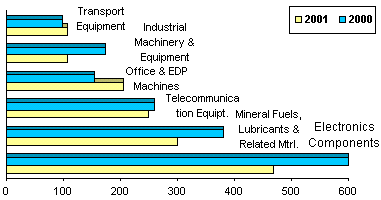
RAW MATERIALS AND INTERMEDIATE GOODS ACCOUNT FOR 39.3 PERCENT OF THE TOTAL IMPORT BILL
Payments for Raw Materials and Intermediate Goods consisting of unprocessed raw materials and semi-processed raw materials accounted for 39.3 percent of the aggregate bill even as importation went down by 12.4 percent to $982.04 million from $1.120 billion.
Capital Goods accounting for 37.2 percent of the aggregate bill declined by 15.8 percent year-on-year growth to $930.48 million from $1.105 billion. The group was led by Telecommunication Equipment and Electrical Machinery valued at $489.35 million or a 19.6 percent share of the total.
Purchases of Mineral Fuel & Lubricant valued at $299.92 million, registered a 21.4 percent decrease from $381.44 million.
Expenditures for Consumer Goods declined by 12.7 percent to $222.99 million from $255.53 million, while Special Transactionswent down by 42.2 percent to $63.98 million from $110.79 million.
Fig. 3. Philippine Imports by Major Type of Goods in September: 2000 & 2001
(F.O.B. Value in Million US Dollar)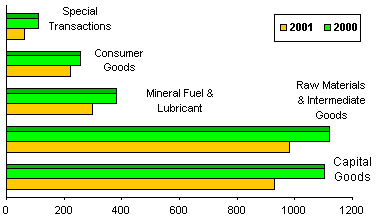
JAPAN CORNERS 20.3 PERCENT OF SEPTEMBER IMPORT BILL
Purchases of Japanese made goods, accounting for 20.3 percent of the total import bill, decreased by 15.1 percent to $506.61 million from $596.60 million a year earlier. Exports to Japan, on the other hand amounted to $393.02 million yielding a two-way trade figure of $899.63 million and a trade deficit for RP placed at $113.58 million.
US, the countrys second biggest source of imports with a 15.0 percent share, reported shipments valued at $375.50 million against exports amounting to $790.01 million. Total trade reached $1.165 billion while trade surplus for the Philippines stood at $414.51 million.
Republic of Korea followed as RPs third biggest source of imports. With payments worth $184.33 million, imports from Korea went down by 6.7 percent from $197.59 million while revenue from RPs exports reached $111.85 million resulting to a total trade value of $296.18 million and a $72.48 million deficit for RP.
Other major sources of imports for the month were: ; Singapore, $159.11 million; Taiwan, $117.29 million; Hongkong, $111.70 million;People's Republic of China, $99.26 million; Saudi Arabia, $92.55 million; Indonesia, $88.74 million; and Islamic Republic of Iran,$87.08 million.
Payment for imports from the top ten sources for the month amounted to $1.822 billion or 72.9 percent of the total.
Fig. 4. Philippine Imports by Country in September: 2001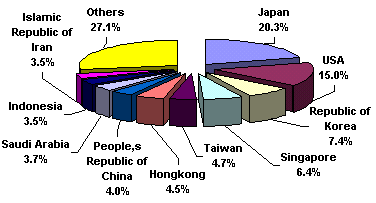
UNCOLLECTED DOCUMENTS
As of press time 93 out of 53,988 export documents and 111 out of56,374 import documents are still expected from the ports.
Source: National Statistics Office
Manila, Philippines

